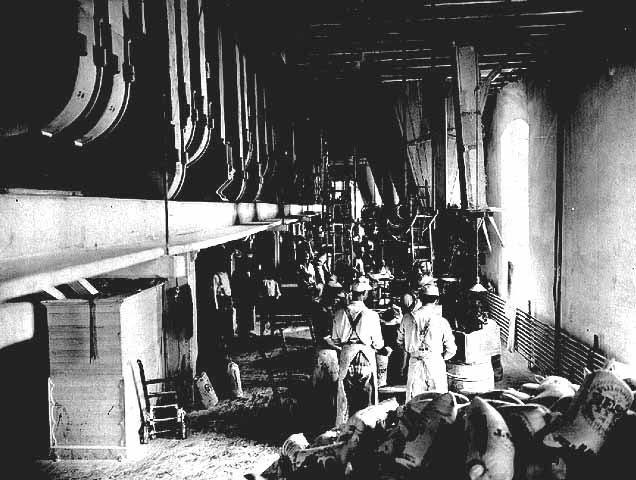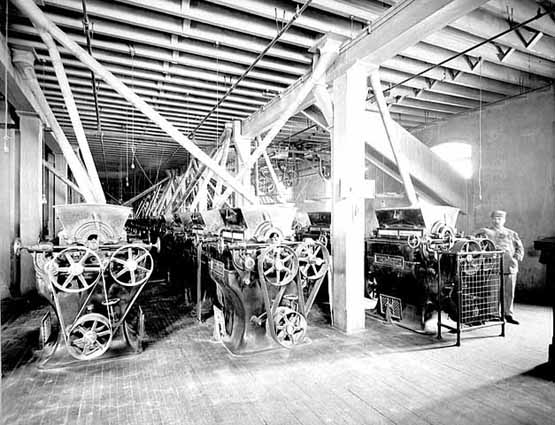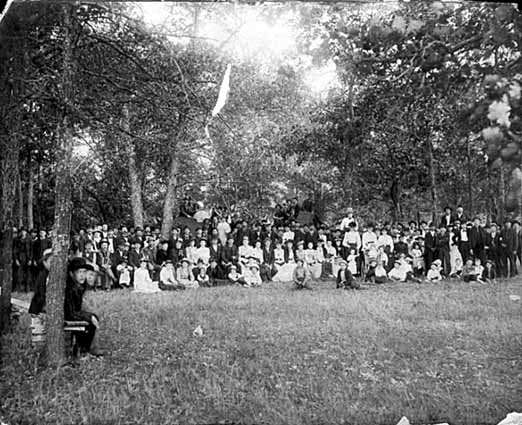Working in the Mills
Was it Hard Work?

Packing flour, Pillsbury A Mill, Minneapolis, 1902.
Minnesota Historical Society Photograph Collection, Location no. HD7.12 p15 Negative no. 10990
FG: "No, it wasn't hard labor in the mill. The only hard labor there was the packing and loading. When you'd stand outside in the cold and throw those 100-pounders twelve high, that's hard work. But in the mill, it was a lot of running. If that mill choked up, oh man!"
HP: "Yes, it didn't take long and you've got a big pile...."
FG: "Oh! you'd get piles and you'd be just soaked with sweat. You'd have to comb your wrists to get the goo balls out."
HP: "You had to shower at night because it was just like flour with water…that mixture."
FG: "We combed our hairs on our arms to comb it out. "
HP: "You'd freeze your hand and the hairs on your arm would…"
FG: "I'd take my eyes like this and pull out long strings of flour out of my… Remember that, Harold?"
HP: [laughter] "Yes, I do. "
FG: "It was very hard work if the mill didn't run…oh! especially these big reels if they plugged up. They were huge things and they separated the grains and stuff. You'd have to get on there with this turner and you'd turn that thing, just trying to break it lose. Then, you'd try to run a belt on it, get that belt and get that thing going. Oh, you would sweat a ton. You had to be young. And to run up those floors…"
—from an interview with mill workers Fred Graf and Harold Peterson.
Oral History with Fred Graf and Harold Peterson, conducted by the Minnesota Historical Society for the Mill City Museum. Interviewed by Ayesha Shariff and Paul Blankman, August 30, 2001.
The Industrial Revolution in Minneapolis

Interior, Pillsbury-Washburn A Mill, Minneapolis, 1897.
Minnesota Historical Society Photograph Collection, Location no. MH5.9 MP3.1P p71 Negative no. 45943
The strength of the Minneapolis milling industry was based on (1) technologies that improved quality (middlings purifier and steel rollers), and (2) large-scale use of machines that increased the efficiency and reduced the cost of the finished product. This was the ideal of the industrial revolution: large-scale mechanization of processes to make products cheaper and better.
Millers' Picnic

July 4th picnic near North Branch, 1893
Minnesota Historical Society Photograph Collection, GT4.5 p28
"Every year I receive numerous invitations to make addresses at various society gatherings, but there is none that I deem it more pleasure to face on audience than at the millers' annual excursion. This is not mere talk, for I have various reasons. First, that the representatives are a skilled class of workingmen: second, that their work is the most necessary in the city, as the result is what the people of the country, term 'the staff of life' and live upon. For one, I love to see people enjoy themselves. …"
—Minneapolis' Mayor Ames at the 8th annual picnic of the Minneapolis Millers, 1888.
"The Dusties on a Lark," the Saint Paul Globe, June 24, 1888.

